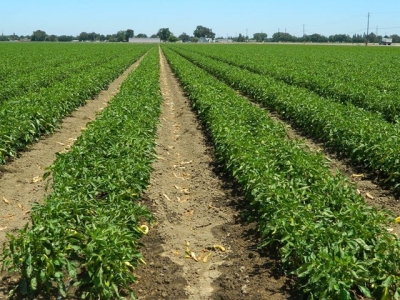Understanding nitrogen fertilisation in vegetables – part 3

Different vegetables require a “push” at different stages, which is why it is important to understand how nitrogen works in the soil, and its subsequent availability.
More water was delivered here close to the sprinkler. Nitrogen leaching is clearly evident.
Other fertiliser elements are more or less stable after basic fertilisation and planting, but not nitrogen. It can be likened to the accelerator on a car, which governs the speed. Sometimes you need to go fast and other times slowly. The same with crops. If you lose control over the amount and availability of nitrogen in your vegetables, it will do just as much damage as losing control over the your car’s accelerator.
Beware of deficiencies
Having both ammonia and nitrate in the soil is a safety feature as the ammonia is the reserve, not very available but secure against leaching. The nitrate will push the plant until the ammonia becomes available and takes over. I had a client in the Free State who would apply all his nitrogen in a band below the root system of his cabbages at planting. He used urea. I warned him of the danger of this as he could lose it all in one go when it was converted to nitrate.
He replied that it had worked well for him for the past few years and that he would continue as it was convenient. Then I got a very agitated call from him. Something had gone terribly wrong and his cabbages weren’t growing. I visited him and found a classic nitrogen deficiency. This time, he listened.
Fixing soil pH
Many fertiliser representatives have a fixation on soil pH. If it gets a little higher than 7, they get agitated and alarm the farmer by outlining all the elements that could become unavailable. Fairly recently, this drove an excellent farmer to approach me. I asked him what he thought of his crops. He replied that they were all doing extremely well, and I told him not to mess with a formula that works so well for him.
The pH is usually better addressed by getting the cations balanced that by trying to reduce it with ammonia nitrogen. All nitrogen acidifies the soil when it leaches. As an anion, it will attach to a cation, which will be leached out with it. Ammonium sulphate will have an even greater acidifying affect as it also contains sulphur. Ammonia can kick calcium off the soil colloid, where it can combine with an anion such as nitrate and be leached.
Limestone ammonium nitrate (LAN) takes this acidifying effect into account and includes calcium to partially counteract it. If the soil pH is too high for your liking, you’re better off looking at the cation balance before taking any other course of action. Losing control of the accelerator to try address the problem will only waste time.
Planning for the seasons
Now that you know how and when nitrogen will be available, you can plan for difficult times. When winter approaches in cool, summer rainfall areas, we know the ammonia fraction will become unavailable in the cold and make timeous applications of LAN. From some time in April, the soil temperature will usually drop to 10ºC. We need to have applied enough LAN in March to provide for this. By the time the ammonia fraction becomes available the rain should have stopped, making leaching unlikely.
You can then build up a nitrate reserve, though you have to be careful not to over-irrigate and leach it out. You have to scale down irrigation rates as evaporation and the transpiration rate will be much lower at this time.
Related news
Tools

Phối trộn thức ăn chăn nuôi

Pha dung dịch thủy canh

Định mức cho tôm ăn

Phối trộn phân bón NPK

Xác định tỷ lệ tôm sống

Chuyển đổi đơn vị phân bón

Xác định công suất sục khí

Chuyển đổi đơn vị tôm

Tính diện tích nhà kính

Tính thể tích ao




 Potting Soil Mix Explained: Ingredients and Labels
Potting Soil Mix Explained: Ingredients and Labels  Understanding nitrogen fertilisation in vegetables – part 1
Understanding nitrogen fertilisation in vegetables – part 1